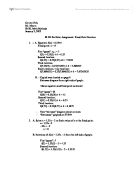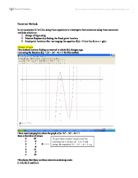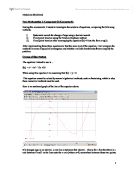Carrera Falk
Mr. Moore
IB HL Math Methods
January 3, 2003
IB HL Portfolio Assignment: Fixed-Point Iteration
. i. A. Equation: f(x) = 0.25+6
Fixed point: x = 8
First "guess": xn-1 = 1
f(1) = 0.25(1) + 6 = 6.25
Second iteration:
f(6.25) = 0.25(6.25) +6 = 7.5625
Third iteration:
f(7.5625) = 0.25(7.5625) + 6 = 7.890625
Fourth iteration: <my iteration>
f(7.890625) = 0.25(7.890625) + 6 = 7.97265625
B. - Copied axes located on page 6
Staircase diagram from right side of graph:
<Same equation and fixed point as above>
First "guess": 20
f(20) = 0.25(20) + 6 = 11
Second iteration:
f(11) = 0.25(11) + 6 = 8.75
Third iteration:
f(8.75) = 0.25(8.75) + 6 = 8.1875
- New "staircase" diagram shown on axes
- "Staircases" graphed on TI-83+
2. A. Solve x = 1.25x - 2 to find a value of x at the fixed point:
x= 1.25x -2
-.25x = -2
Mr. Moore
IB HL Math Methods
January 3, 2003
IB HL Portfolio Assignment: Fixed-Point Iteration
. i. A. Equation: f(x) = 0.25+6
Fixed point: x = 8
First "guess": xn-1 = 1
f(1) = 0.25(1) + 6 = 6.25
Second iteration:
f(6.25) = 0.25(6.25) +6 = 7.5625
Third iteration:
f(7.5625) = 0.25(7.5625) + 6 = 7.890625
Fourth iteration: <my iteration>
f(7.890625) = 0.25(7.890625) + 6 = 7.97265625
B. - Copied axes located on page 6
Staircase diagram from right side of graph:
<Same equation and fixed point as above>
First "guess": 20
f(20) = 0.25(20) + 6 = 11
Second iteration:
f(11) = 0.25(11) + 6 = 8.75
Third iteration:
f(8.75) = 0.25(8.75) + 6 = 8.1875
- New "staircase" diagram shown on axes
- "Staircases" graphed on TI-83+
2. A. Solve x = 1.25x - 2 to find a value of x at the fixed point:
x= 1.25x -2
-.25x = -2







